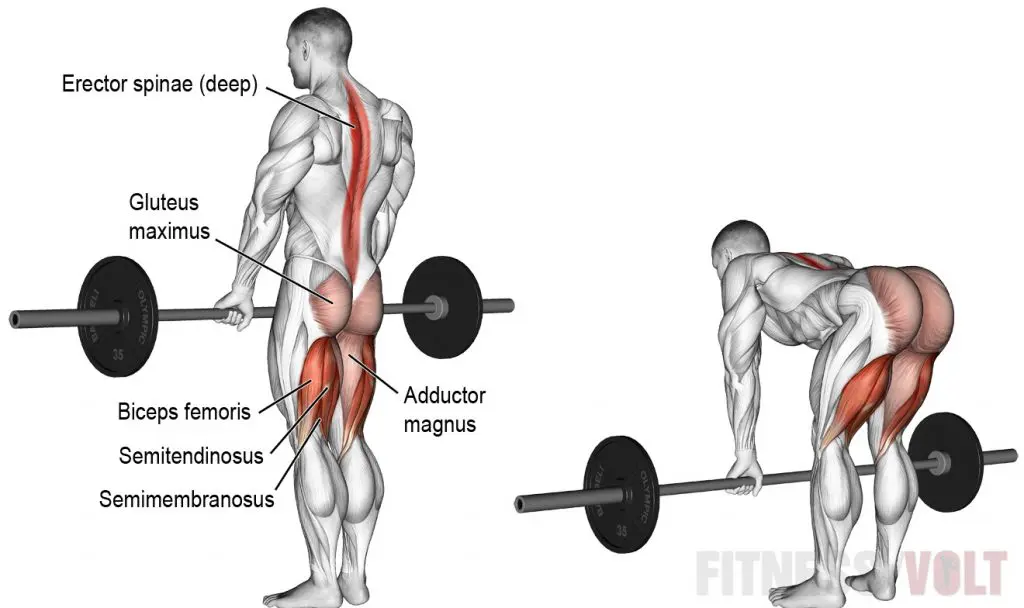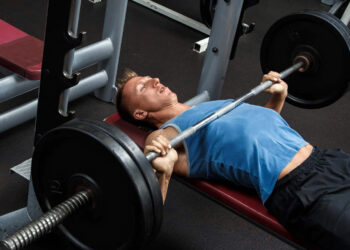If you are used to training in a gym, you may be unsure how to get a good workout at home. After all, gyms are packed with every training tool you could possibly need. Leg day? Jump on the leg press! Chest day? Hit the bench press! Training at home is much more limiting, especially if you aren’t lucky enough to have workout equipment of your own.
But the good news is that, with nothing more than your body weight, some dumbbells, and resistance bands, you have everything you need to get and stay in shape at home.
Here are FIVE of the best at-home workouts, all tried, tested, and just for you!
But, before attempting any of these workouts, make sure you spend a few minutes warming up and preparing your body for what you are about to do. Start with a few minutes of easy jogging or jumping rope, followed by dynamic stretches and joint mobility exercises for the body parts you are about to train.
Finally, do 1-2 warmup sets for the main exercises before you do your working sets. Warming up should only take 5-10 minutes but will make your workout much more productive and could even stop you from getting injured.
#1 – Bodyweight-only full-body blast
No exercise equipment? That’s not a problem with this bodyweight-only full-body workout. As the name suggests, it is designed to work your entire body using a range of equipment-free exercises. All you need is a few yards of space and a mat or towel to lie on.
Level Up Your Fitness: Join our 💪 strong community in Fitness Volt Newsletter. Get daily inspiration, expert-backed workouts, nutrition tips, the latest in strength sports, and the support you need to reach your goals. Subscribe for free!
Do 2-4 sets of the following exercises, resting 60-90 seconds between sets.
| No. | Exercise | Sets | Reps |
| 1 | Speed skater | 2-4 sets | 6-12 reps per leg |
| 2 | Decline push-ups | 2-4 sets | AMRAP |
| 3 | Pull-ups | 2-4 sets | AMRAP |
| 4 | Single leg hip-thrusts | 2-4 sets | 10-15 reps per leg |
| 5 | Pike push-ups | 2-4 sets | AMRAP |
| 6 | Body rows | 2-4 sets | 8-12 reps |
| 7 | V-sits | 2-4 sets | 10-15 reps |
| 8 | Prone back extensions | 2-4 sets | 10-15 reps |
*As Many Reps As Possible (AMRAP)
Exercise descriptions
1 – Speed skater squats
This challenging squat variation works your quads, hamstrings, and glutes. It’s also useful for developing your stability and balance. Do it next to a wall for support, if necessary, then try to progress towards doing it unaided as your performance improves.
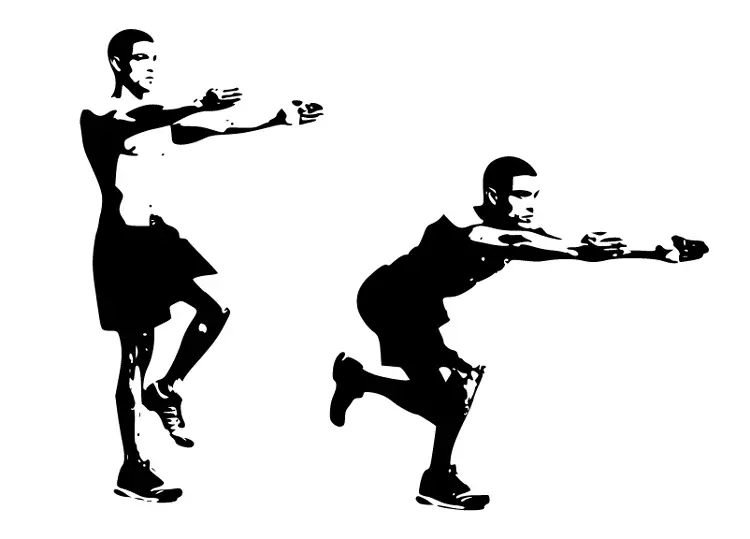
- Stand on one leg with your opposite leg bent. Extend your arms in front of you for balance.
- Bend your supporting leg and squat down until your other knee is just a few inches off the floor.
- Stand up and repeat. Rest a moment and then do the same number of reps on the opposite leg.
2 – Decline push-ups
Elevating your feet makes this push-up variation more challenging and better for building muscle and strength than regular push-ups. The higher your feet, the more weight there will be on your arms and chest.
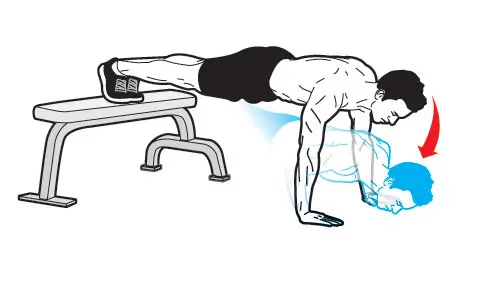
- Adopt the push-up position with your arms straight and feet on a knee-high chair. Place your hands just wider than shoulder-width apart. Pull your shoulders down and back and brace your abs.
- Bend your arms and lower your chest to within an inch or two of the floor. Do not drop your hips or hyperextend your spine.
- Push yourself back up and repeat.
3 – Pull-ups
This is arguably the best bodyweight back and biceps exercise you can do. All you need is a ceiling joist, tree branch, or something similar to hang from. You can also do pull-ups from the top of a door.
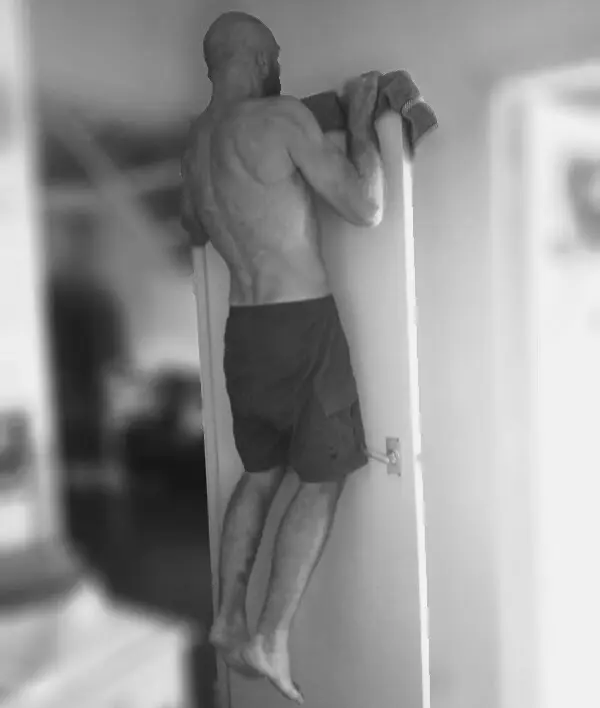
- Hold your bar with a slightly wider than shoulder-width grip. Hang with your arms straight and legs bent, so your feet are clear of the floor.
- Bend your arms and pull yourself up until your chin is level with or above your hands.
- Extend your arms and repeat.
4 – Single-leg hip thrusts
Single-leg hip thrusts work your hamstrings, glutes, and lower back, although they place minimal stress on your spine. Using one leg at a time will help identify and fix any left-to-right posterior chain strength imbalances.
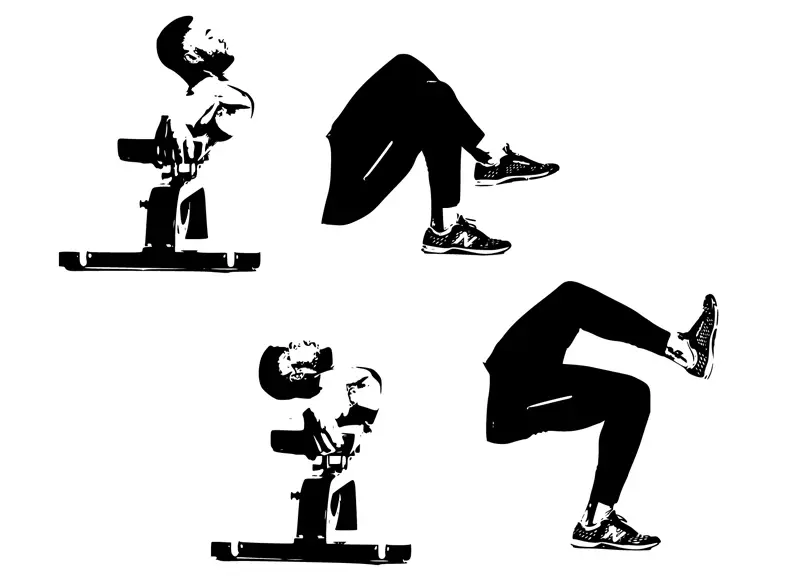
- Lie on your back with your legs bent and feet flat on the floor. Flexing your hip, lift one leg and pull it into your chest.
- Drive your other foot into the floor and lift your butt up until your knee, hips, and shoulders form a straight line.
- Lower your butt back down to the floor and repeat. Do the same number of reps on each leg.
5 – Pike push-ups
Pike push-ups are the bodyweight equivalent of barbell or dumbbell shoulder presses. They work your deltoids as well as your triceps.
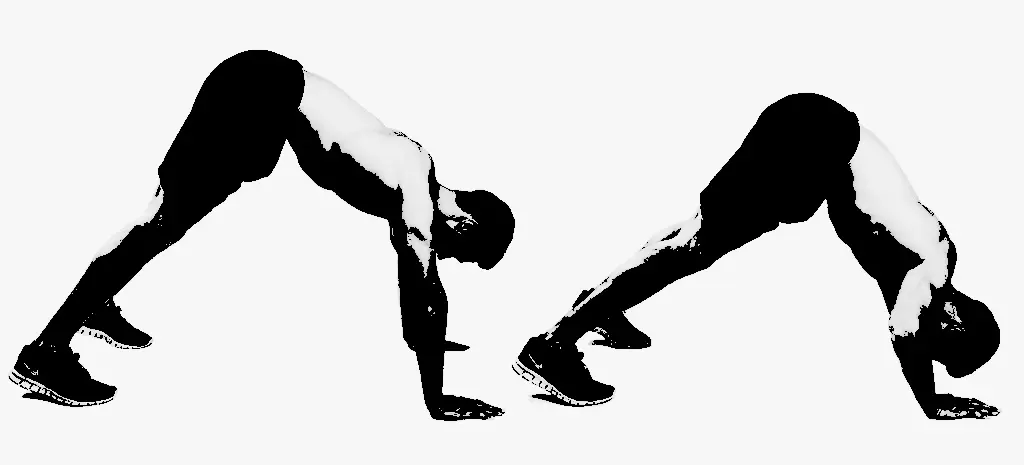
- Adopt the push-up position with your legs and arms straight, hands a little wider than shoulder-width apart. Walk your feet in toward your hands and lift your butt into the air, so your body resembles an inverted V-shape.
- Bend your arms and lower your forehead to the floor.
- Extend your arms and repeat.
6 – Body rows
Body rows are the second-best bodyweight back exercise. Most people do this exercise using a TRX suspension trainer or gymnastic rings. Still, you can also do them using nothing more than a table or a broomstick between two tall chairs.
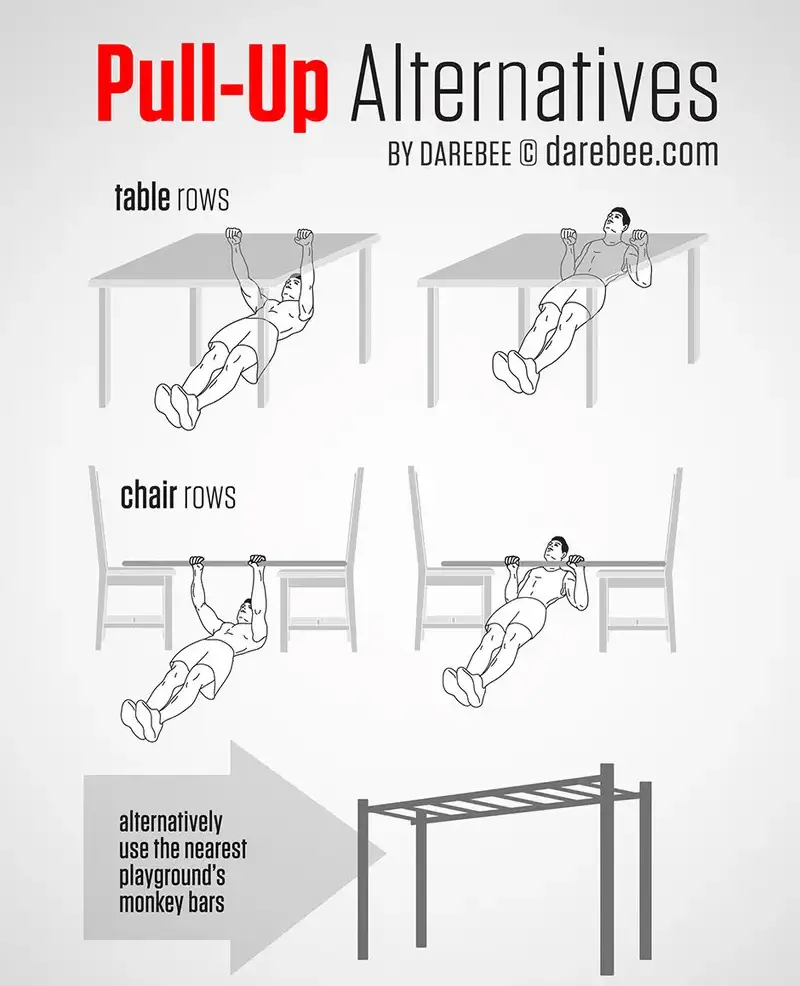
- Lie beneath a sturdy table, legs straight. Reach up and grab the edge of the table with a shoulder-width, overhand grip. Lie back with your arms straight. Lift your butt off the floor.
- Keeping your body straight, bend your arms and pull your chest up to the underside of the table.
- Extend your arms and repeat.
7 – V-sits
This challenging old-school abs exercise has fallen out of favor over the last few years. However, it’s still an excellent way to develop the washboard abs you always dreamed of!
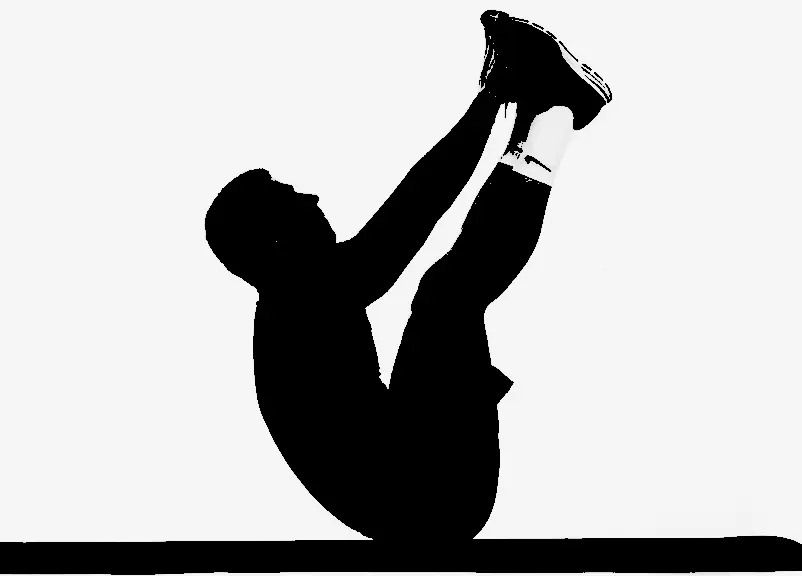
- Lie on the floor on your back with your legs straight and your arms above your head.
- Simultaneously lift your legs and upper body off the floor, reaching up to touch your toes. Your body should resemble a V-shape.
- Lie back down and repeat.
Review: Looking for best home gym options? Here are 13 Best Home Gyms reviewed for 2021
8 – Prone back extensions
This bodyweight exercise works your erector spinae, which are the muscles that support and extend your spine. Strong erector spinae may help protect your lower back from injury.
- Lie on your front with your hands clasped behind your lower back.
- Keeping your feet down, lift your head, shoulders, and chest about 12 inches off the floor
- Lie back down and repeat.
#2 – Dumbbell upper body workout
If you’ve got some adjustable dumbbells gathering dust, now is the time to bring them out. This workout targets your entire upper body, and you don’t even need a bench!
Do 2-4 sets of the following exercises, resting 60-90 seconds between sets.
| No. | Exercise | Sets | Reps |
| 1 | Dumbbell floor press | 2-4 sets | 8-12 reps |
| 2 | Dumbbell bent-over rows | 2-4 sets | 8-12 reps |
| 3 | Dumbbell floor flys | 2-4 sets | 8-12 reps |
| 4 | Dumbbell renegade rows | 2-4 sets | 8-12 reps per arm |
| 5 | Dumbbell three-way shoulder complex | 2-4 sets | 8-12 reps per exercise |
| 6 | Dumbbell skull-crushers | 2-4 sets | 8-12 reps |
| 7 | Dumbbell alternating curls | 2-4 sets | 8-12 reps per arm |
*As Many Reps As Possible (AMRAP)
Exercise descriptions
1 – Dumbbell floor press
No bench? No problem! This old-school exercise works your chest, shoulders, and triceps, and it’s easy on your shoulders too.
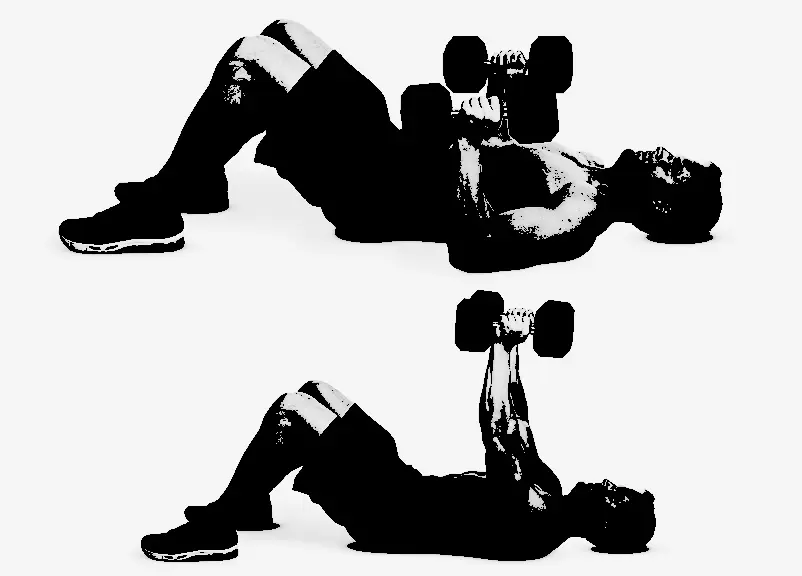
- Lie on the floor with a dumbbell in each hand, press them up to arms’ length over your chest. Turn your hands so your palms are facing your feet. Bend your legs and plant feet firmly on the floor for stability. Pull your shoulders down and back and brace your abs.
- Bend your arms to lower the weights down until the back of your upper arms touch the floor. Tuck your elbows slightly into your sides as you descend.
- Drive the weights back up and repeat.
2 – Dumbbell bent-over rows
Work your lats, mid-traps, rhomboids, and posterior deltoids, as well as your biceps and posterior chain with this simple but challenging exercise.
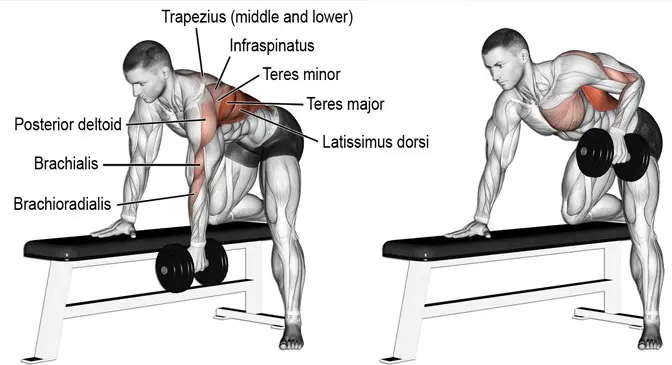
- With a dumbbell in each hand, stand with your feet hip-width apart, knees slightly bent.
- Hinge forward from your hips until your body is between 45 degrees and parallel to the floor. Let your arms hang straight down from your shoulders.
- Without rounding your lower back or jerking with your legs, row your dumbbells up and into your ribs. Keep your arms close to your sides, wrists straight, and shoulders back.
- Extend your arms and repeat.
3 – Dumbbell floor flys
With minimal triceps involvement, this exercise emphasizes your chest. It’s harder than floor presses, so adjust the weight of your dumbbells accordingly.
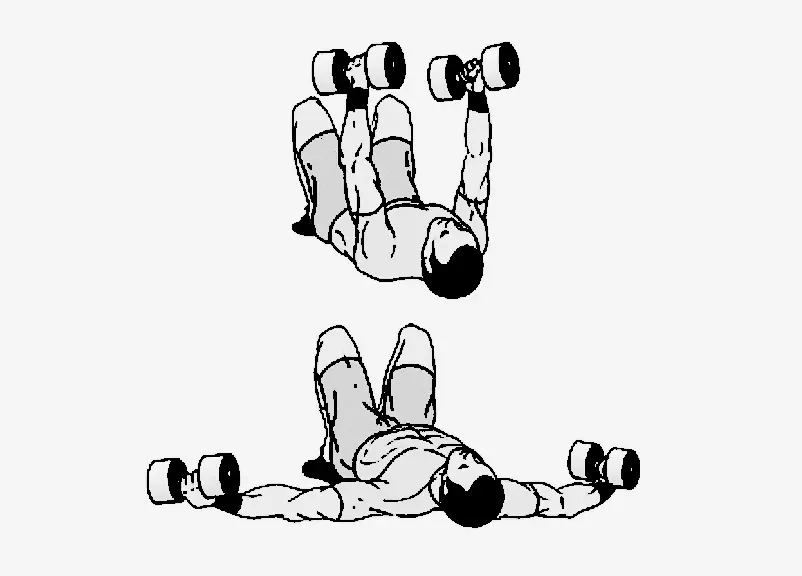
- Lie on the floor with a dumbbell in each hand, pressed up to arms’ length over your chest. Turn your hands, so your palms are facing inward. Bend your legs and plant feet firmly on the floor for stability. Pull your shoulders down and back and brace your abs. Bend your elbows slightly, but then keep them rigid throughout.
- Open your arms and lower the weights out to the side. Descend until your upper arms touch the floor.
- Squeeze your arms together and repeat.
4 – Dumbbell renegade rows
The dumbbell renegade row is an effective back exercise that also works your core. It’s very challenging, so use light weights until you have mastered it.
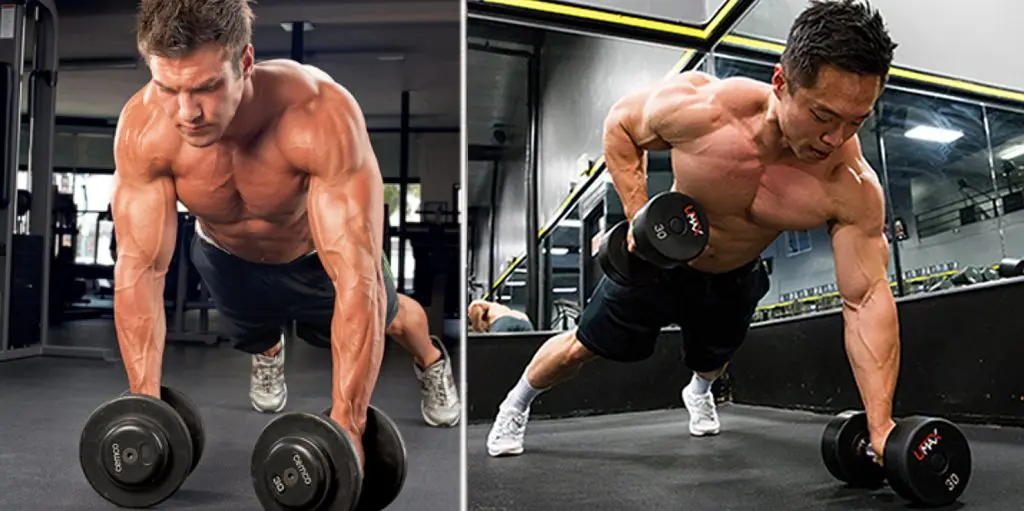
- Adopt the push-up position with a dumbbell in each hand. Brace your abs and pull your shoulders down and back to keep them stable. Place your feet a little wider apart than usual for balance.
- Bend one arm and pull your dumbbell up and into your ribs. Work hard to keep your shoulders and hips level.
- Extend your arm and put your dumbbell back on the floor. Repeat on the opposite side and then continue alternating sides for the duration of your set.
5 – Dumbbell four-way shoulder complex
Combining four exercises into one, this dumbbell shoulder complex will leave your delts burning and crying for mercy! Use the same dumbbells/weights for all four exercises.
Level Up Your Fitness: Join our 💪 strong community in Fitness Volt Newsletter. Get daily inspiration, expert-backed workouts, nutrition tips, the latest in strength sports, and the support you need to reach your goals. Subscribe for free!
- Stand with your feet shoulder-width apart, a dumbbell in each hand, and arms by your sides. Your palms should be facing your thighs.
- Raise your arms up and out to the side at about shoulder-height. Keep your elbows slightly bent but rigid. Lower your arms to your sides and repeat for desired reps.
- Next, move your dumbbells and hold them in front of your thighs. Turn your palms to face your legs. Raise your arms forward and up to shoulder height and then lower them back to your legs and repeat for desired reps.
- Keeping the dumbbells in front of your legs, bend your arms and row/pull the weights up the front of your body to your chest. Lead with your elbows and keep your wrists straight. Lower your dumbbells back down and repeat for desired reps.
- Finally, curl the dumbbells up to your shoulders. Turn your hands, so your palms are facing away from you. Press the weights up overhead to arms’ length, and then lower them back to your shoulders. Repeat for the prescribed number of reps.
6 – Dumbbell skull-crushers
Dumbbell skull crushers are arguably a better triceps exercise than EZ and barbell skull crushers. Not only are you less likely to hit yourself on the head, but the range of motion is also greater.
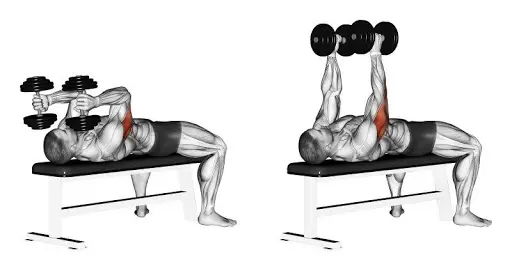
- Lie on the floor with a dumbbell in each hand, arms extended and palms facing inward.
- Keeping your upper arms stationary, bend your elbows, and lower the weights down to your temples.
- Extend your arms by flexing your triceps and repeat.
7 – Dumbbell alternating curls
This popular exercise involves two of the three actions of your biceps – elbow flexion and forearm supination. This makes it a very useful exercise for building size and functional strength.

- Stand with your feet shoulder-width apart for balance. Hold a dumbbell in each hand, arms by your side, and palms facing your legs.
- Begin to curl one dumbbell and as your arm reaches a 90-degree angle, rotate your wrist, so your palm is uppermost. Curl the weight up to your shoulder.
- Reverse the action to lower the dumbbell and then do another rep on the opposite side. Continue alternating arms for the duration of your set.
#3 – Burpees and jump rope cardio workout
You don’t need a treadmill or an exercise bike to do cardio, you don’t even need to leave your home. This low-tech but high-effect workout will build fitness and endurance in the confines of your house. All you need is a jump rope, a timer, and a little bit of space.
Do 5 laps of the following interval training sequence…
| No. | Exercise | Time |
| 1 | Jump rope | 2 minutes |
| 2 | Burpees | 1 minutes |
| 3 | Rest | 1 minutes |
Exercise descriptions
1 – Jump rope
Jumping rope is a simple but very effective way to improve your cardiovascular fitness at home. A basic $20 PVC speed rope is all you need. Jumping rope is also good for your coordination and will give your calves and shoulders a good workout too.
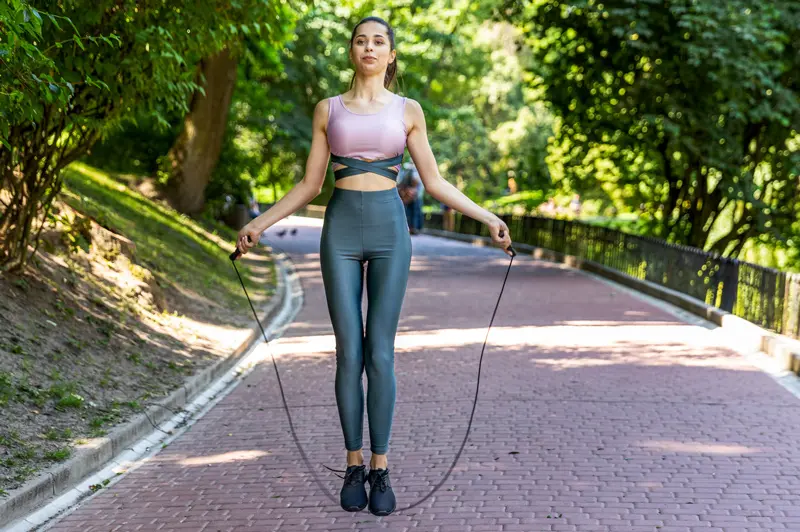
- Make sure your rope is the right length for you. Stand on the middle and pull the handles up to your armpits. If the end of the handles reaches your ‘pits, the rope is the correct length. If it’s too long, tie knots in it to shorten. If it’s too short, discard it and get another one.
- Jump rope in whatever style you like, including feet together, using a heel-toe action, or running on the spot. Give yourself five push-ups every time you trip!
2 – Burpees
It’s doubtful that any bodyweight exercise involves more muscles than burpees. They might be tough, but burpees are hard to beat for at-home conditioning and fitness.
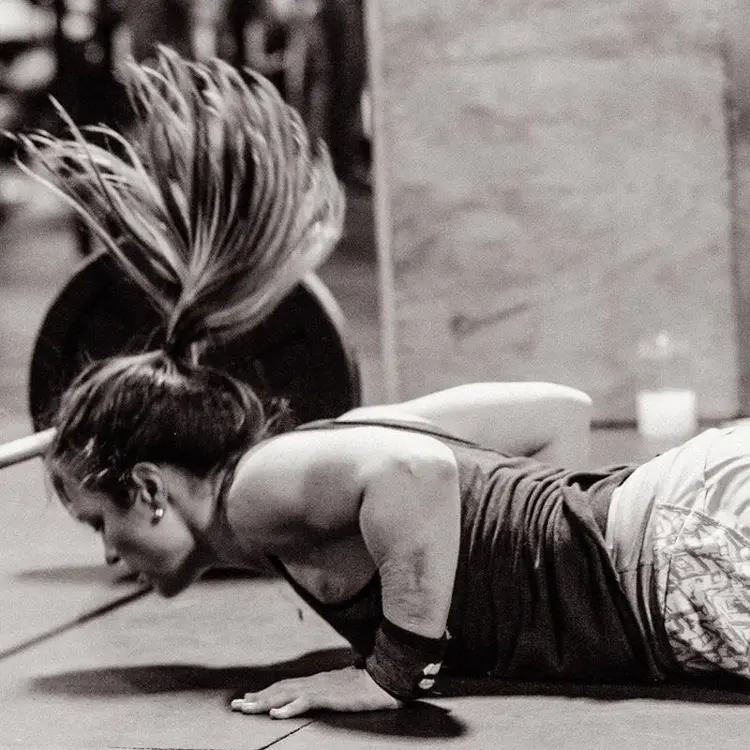
- Stand with your feet together, hands by your sides.
- Squat down and place your hands flat on the floor just inside your feet.
- Jump your feet out and back into the push-up position. Do one push-up.
- Jump your feet back up to your hands, and then leap into the air.
- Land on slightly bent knees and repeat.
3 – Rest
Grab a drink, mop the sweat from your brow, do a few stretches, and then get ready to go again! If you want a harder workout, reduce the length of your rests to 30-45 seconds. Rest for longer to make this work out more manageable.
#4 – Dumbbell lower body workout
At the gym, most leg workouts involve exercises like barbell squats, leg presses, leg extensions, and leg curls. Training at home doesn’t mean you can forgo leg training. In fact, all you need is some dumbbells to develop a lower body you can be proud of, and without stepping foot in a gym.
Do 2-4 sets of the following exercises, resting 60-90 seconds between sets.
| No. | Exercise | Sets | Reps |
| 1 | Paused goblet squats | 2-4 sets | 12-15 reps |
| 2 | Romanian deadlifts | 2-4 sets | 10-12 reps |
| 3 | Split squats | 2-4 sets | 10-12 reps per leg |
| 4 | Dumbbell swings | 2-4 sets | 15-20 reps |
| 5 | Dumbbell squat jumps | 2-4 sets | 8-12 reps |
| 6 | Goose steps | 2-4 sets | 45-60 seconds |
Exercise descriptions
1 – Paused goblet squats
Goblet squats are an excellent alternative to barbell squats but, unless you’ve got access to very heavy dumbbells, it’s probably not hard enough for most exercisers. Adding a deliberate mid-rep pause makes them much more challenging.
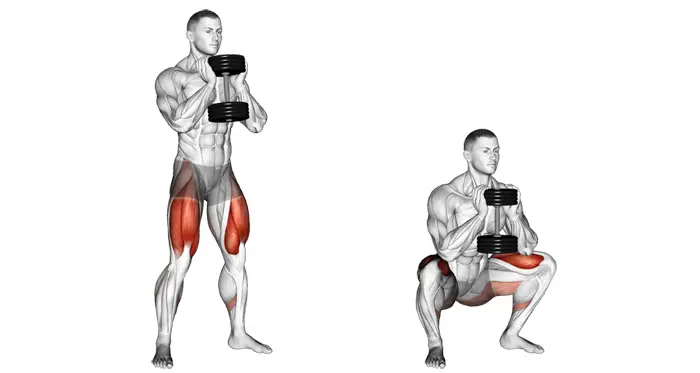
- Hold a single dumbbell in front of your chest. It should be vertical, and your hands should be palms up against the inside of the uppermost weight plate. Step out, so your feet are shoulder-width apart, toes turned slightly outward.
- Push your hips back and bend your knees. Squat down until your thighs are roughly parallel to the floor. Do not round your lower back.
- Stand back up and repeat.
2 – Romanian deadlifts
This classic posterior chain exercise is usually done with a barbell. Still, it’s just as good when done with dumbbells. In fact, dumbbells allow you to keep the weights closer to your base of support and in line with your feet, which can take stress off your lower back.
- With a dumbbell in each hand, stand with your feet hip-width apart, knees slightly bent. Hold the weights at your sides.
- Push your hips back and hinge forward from your hips. Lower the weights down your legs without rounding your back. Go as far as your flexibility allows.
- Stand back up and repeat. Avoid leaning back at the top as this merely increases lower back strain.
3 – Split squats
Split squats are a type of static lunge. They work all of your major leg muscles but place an emphasis on your quads. They are also good for your balance and hip mobility.
- Step forward and into a split stance, holding a dumbbell in each hand. Keep your arms by your sides.
- Bend your legs and lower your rearmost knee down to within 1-2 inches of the floor. Straighten your legs and then, without moving your feet, repeat. On completion of the prescribed reps, rest a moment, change legs, and do another set on the opposite side.
4 – Dumbbell swings
This powerful posterior chain exercise is also good for endurance and conditioning. Generally done with a kettlebell, there is no reason not to do this exercise with a single dumbbell.
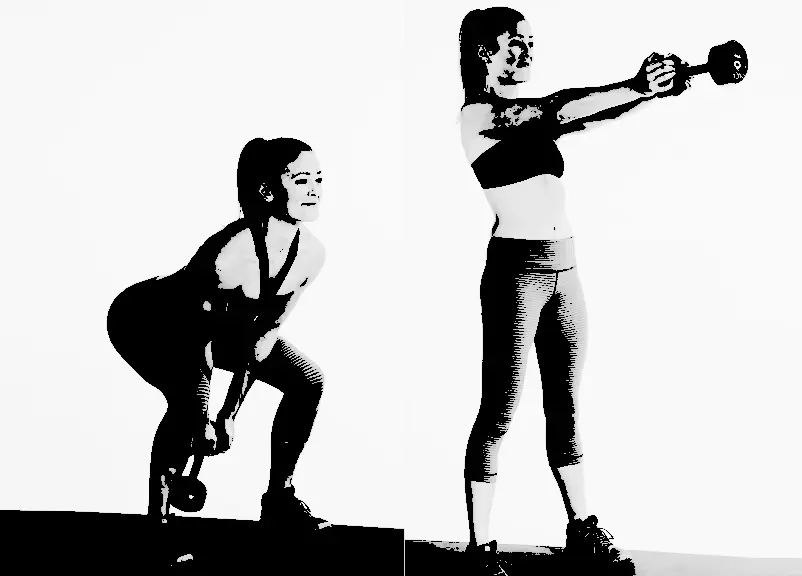
- Hold a single dumbbell in two hands. Stand with your feet shoulder-width apart, knees slightly bent. Push your hips back, hinge forward, and lower the weight between your knees.
- Thrust your hips forward and use this momentum to swing the weight forward and up to shoulder-height.
- Lower your dumbbell and repeat.
5 – Dumbbell squat jumps
Your final hip and thigh exercise is designed to fully exhaust the target muscles and also develop your explosive strength and power. Jump as high as you can – do not leave any energy left in the tank!
- Hold a dumbbell in each hand and stand with your feet between shoulder and hip-width apart.
- Squat down until your thighs are parallel to the floor without rounding your lower back.
- Leap up into the air as high as you can.
- Land on bent knees so absorb the shock and then descend into another rep.
6 – Goose steps
This old-school calf exercise used to be very popular, but it’s not one you’ll see very often anymore. That’s a shame because it’s a very effective, if somewhat odd-looking lower leg exercise.
- Stand with your feet together and a dumbbell in each hand. Rise up on to your tiptoes.
- Without lowering your heels to the floor, walk around your training area until the prescribed time has elapsed.
#5 – Bodyweight and jump rope 20-minute conditioning circuit
This simple home workout will work all of your major muscles while simultaneously developing your cardiovascular fitness. If you only have 20 minutes to work out, this is a very time-efficient training session that crams a lot of exercise into a short period.
Do 10 laps of the following exercise sequence, moving quickly from one exercise to the next.
Do one lap every two minutes. Upon completion of the squats, jump rope until the next two-minute mark.
| No. | Exercise | Laps | Reps |
| 1 | Pull-ups | 10 laps | 5 |
| 2 | Push-ups | 10 laps | 10 |
| 3 | Squats | 10 laps | 15 |
| 4 | Jump rope | 10 laps | – |
Exercise descriptions
1 – Pull-ups
Whether you have a freestanding power tower, a doorway pull-up bar, or a level tree branch/s in your garden, pull-ups are one of the best back and biceps exercises around!
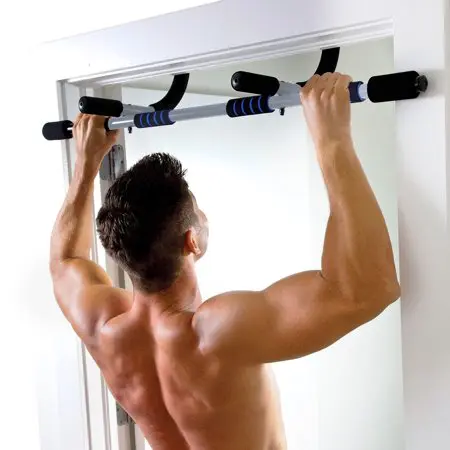
- Hold your bar with a slightly wider than shoulder-width grip. Hang with your arms straight and legs bent, so your feet are clear off the floor.
- Bend your arms and pull yourself up until your chin is level with or above your hands.
- Extend your arms and repeat.
2 – Push-ups
No home workout is complete without push-ups. Working your chest, triceps, and shoulders, push-ups are probably the most widely performed exercise in the world.
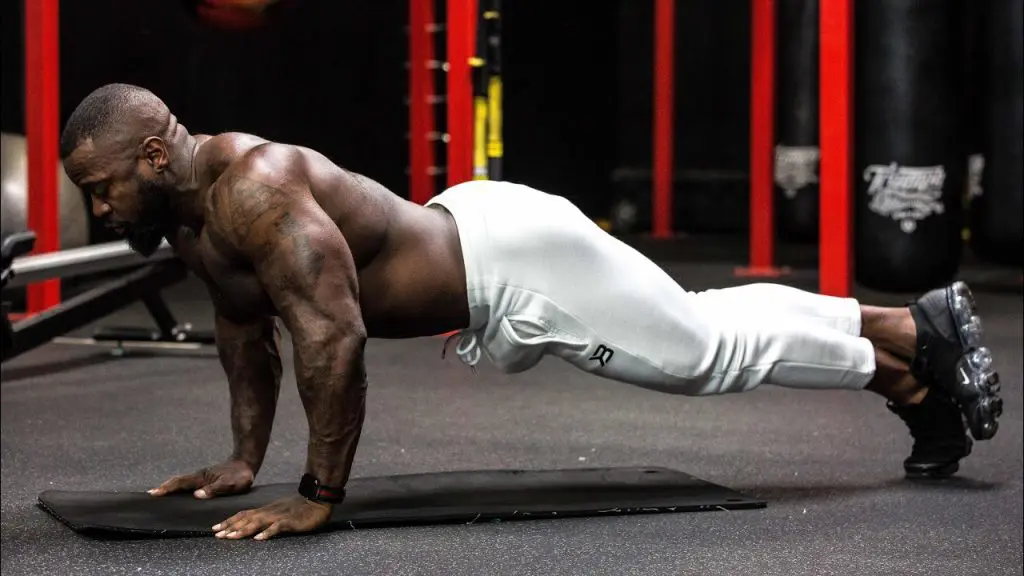
- Squat down and place your hands on the floor. Walk your feet back until your body is straight. Position your hands, so they are just wider than shoulder-width apart. Pull your shoulders down and back and brace your abs.
- Bend your arms and lower your chest to within an inch or two of the floor. Do not drop your hips or hyperextend your spine.
- Push yourself back up and repeat.
3 – Squats
The humble bodyweight squat works all of your major leg muscles. They aren’t the hardest lower body workout around, but they are still an effective endurance exercise.
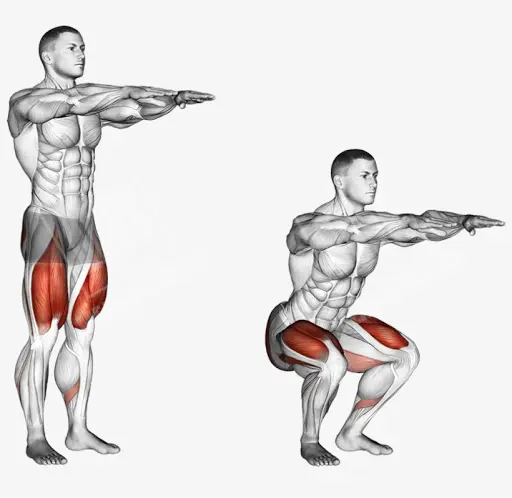
- Stand with your feet shoulder-width apart, toes turned slightly outward.
- Push your hips back, bend your knees, and squat down until your thighs are parallel to the floor. Do not round your lower back.
- Stand back up and repeat.
4 – Jump rope
Jumping rope is your active recovery before starting your next lap of the three exercises for this workout. Adjust your pace to reflect your fitness. Continue until the next two-minute mark.
- Make sure your rope is the right length for you. Stand on the middle and pull the handles up to your armpits. If the end of the handles reaches your ‘pits, the rope is the correct length. If it’s too long, tie knots in it to shorten. If it’s too short, discard it and get another one.
- Jump rope in whatever style you like, including feet together, using a heel-toe action, or running on the spot.
Review: 12 Best Fitness Equipment When Home Workouts Are The Only Option
FAQs
Do you have any home workout questions? We’ve got answers! If you can’t find the information you are looking for below, drop us a line in the comments section, and we’ll get back to you as soon as we can.
How often can (or should) I work out at home?
Providing you vary your workouts, there is no reason you can’t work out four, five, or even six days per week. Avoid doing the same workout on consecutive days, though, as you could end up with an overuse injury. Also, make sure you have 1-2 rest days per week, so you are recovered and refreshed.
Using the workouts in this article, your weekly workout program could look like this:
- Monday – lower body
- Tuesday – upper body
- Wednesday – cardio
- Thursday – rest
- Friday – full body
- Saturday – cardio
- Sunday – rest
I can't do some of the exercises - what can I do instead?
There are ways to make most exercises easier and more manageable. For example, you could do push-ups on your knees, do band-assisted pull-ups, drop the jump from burpees, or just do fewer reps per workout. Alternatively, make a note of the muscles involved and Google an easier exercise that works the same body parts.
How can I make the bodyweight exercises harder?
If bodyweight exercises have a disadvantage, it is that you only have your body weight for resistance. That means, for some people, many of these exercises are just too easy. Make them harder by:
- Doing more than the prescribed number of reps
- Doing more sets
- Taking shorter rests between sets
- Using slower tempo to increase time under tension
- Choosing more advanced versions of the listed exercises
- Wearing a weighted vest or backpack
Are these workouts okay for beginners?
These workouts are mainly aimed at intermediate exercisers, but that doesn’t mean beginners can’t do them too. Do fewer reps and sets of each exercise and take longer rests too. You may also want to do more basic versions of the exercises listed. Finally, give yourself extra time between workouts to recover as doing too much exercise too soon could lead to unnecessary soreness and even injury.
I don't have any dumbbells. What can I use instead?
In place of dumbbells, you can use filled water bottles, canned goods, bags of sugar or flour, bricks or rocks, or anything else that’s heavy but small enough to fit in your hands. You may also be able to use resistance bands instead of dumbbells for some of the exercises.
The wrap-up
Don’t use not having access to a well-equipped gym as an excuse for gaining weight or being unfit or weak. The reality is your body cannot differentiate between a $20,000 leg press machine and doing squats wearing a ratty old backpack loaded with heavy books! Providing you work out hard and often enough, you can get and stay in great shape in the confines of your home. Commit to working out regularly, and you will get the results you want.


